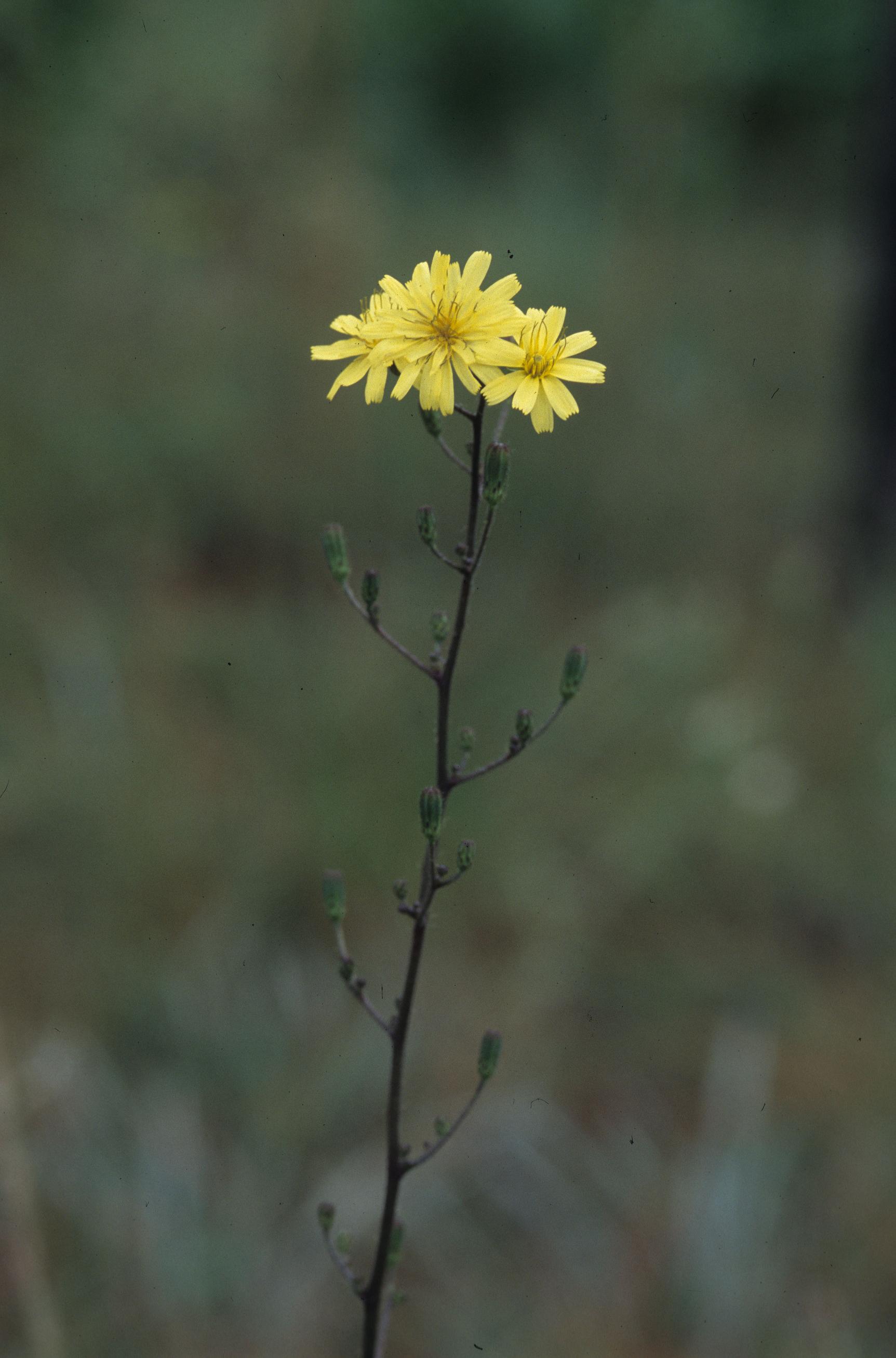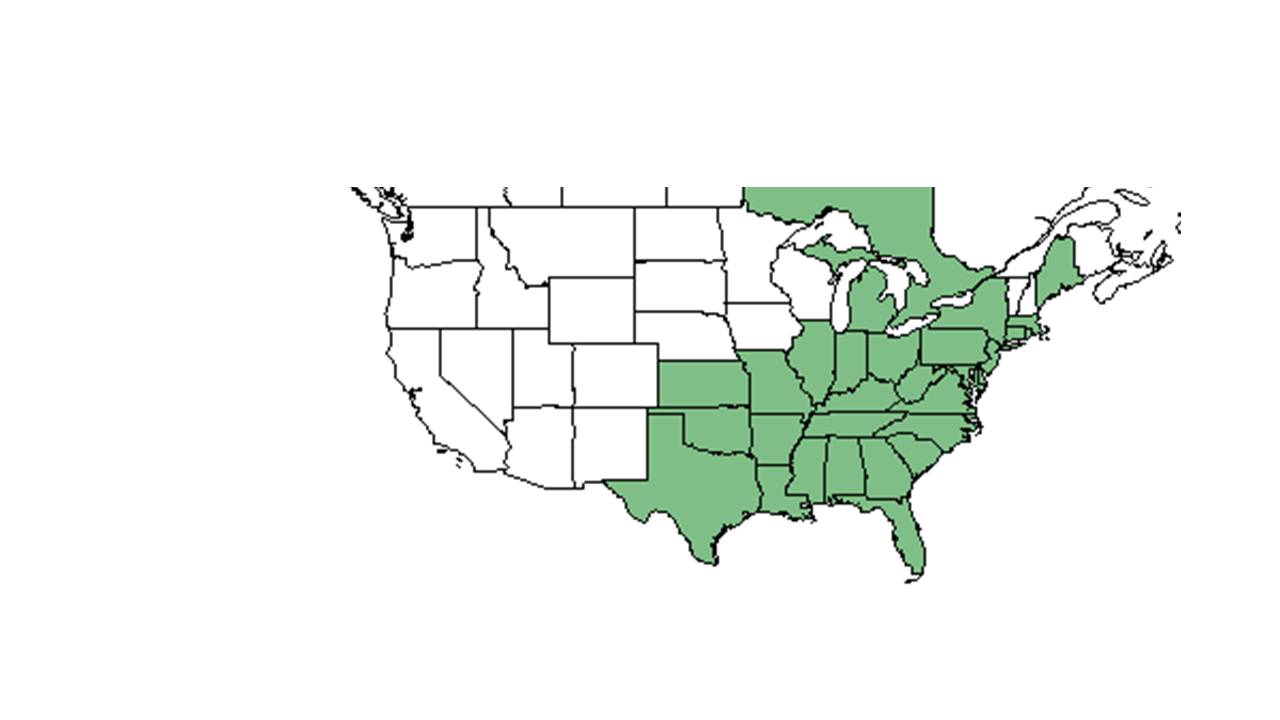Difference between revisions of "Hieracium gronovii"
Ruthstetler (talk | contribs) |
|||
| Line 17: | Line 17: | ||
| range_map_caption = Natural range of ''Hieracium gronovii'' from USDA NRCS [http://www.plants.usda.gov Plants Database]. | | range_map_caption = Natural range of ''Hieracium gronovii'' from USDA NRCS [http://www.plants.usda.gov Plants Database]. | ||
}} | }} | ||
| + | |||
| + | Common name: queendevil | ||
==Description== | ==Description== | ||
<!-- Basic life history facts such as annual/perrenial, monoecious/dioecious, root morphology, seed type, etc. --> | <!-- Basic life history facts such as annual/perrenial, monoecious/dioecious, root morphology, seed type, etc. --> | ||
| − | |||
''Hieracium gronovii'' is a perennial herbaceous species. | ''Hieracium gronovii'' is a perennial herbaceous species. | ||
| Line 38: | Line 39: | ||
===Pollination=== | ===Pollination=== | ||
| − | + | The following Hymenoptera families and species were observed visiting flowers of ''Hieracium gronovii'' at Archbold Biological Station (Deyrup 2015): | |
| − | |||
| − | |||
| − | |||
| − | |||
| − | Halictidae: Lasioglossum coreopsis | + | Halictidae: ''Augochloropsis sumptuosa, Halictus poeyi, Lasioglossum coreopsis'' |
| − | Megachilidae: Anthidiellum perplexum | + | Megachilidae: ''Anthidiellum perplexum'' |
===Use by animals=== <!--Herbivory, granivory, insect hosting, etc.--> | ===Use by animals=== <!--Herbivory, granivory, insect hosting, etc.--> | ||
| Line 56: | Line 53: | ||
==Photo Gallery== | ==Photo Gallery== | ||
==References and notes== | ==References and notes== | ||
| − | + | Deyrup, M.A. and N.D. 2015. Database of observations of Hymenoptera visitations to flowers of plants on Archbold Biological Station, Florida, USA. | |
| − | |||
| − | |||
| − | States and Counties: Florida: Alachua, Bay, Calhoun, Clay, Columbia, Dade, Franklin, Gulf, Hernando, Jackson, Jefferson, Leon, Levy, Liberty, Madison, Nassau, Okaloosa, Osceola, Putnam, Santa Rosa, Taylor, and Wakulla. Georgia: Grady and Thomas. | + | Florida State University Robert K. Godfrey Herbarium database. URL: [http://herbarium.bio.fsu.edu http://herbarium.bio.fsu.edu]. Last accessed: June 2014. Collectors: Loran C. Anderson, Wilson Baker, Robert Blaisdell, Chris Cooksey, George R. Cooley, R. A. Davidson, Richard J. Eaton, J. P. Gillespie, Robert K. Godfrey, S. R. Hill, Richard D. Houk, Ed Keppner, Lisa Keppner, Gary R. Knight, R. Komarek, R. Kral, Robert L. Lazor, Sidney McDaniel, Richard S. Mitchell, John Morrill John B. Nelson, R. A. Norris, R. E. Perdue Jr., James D. Ray Jr., Paul L. Redfearn Jr., Cecil R. Slaughter, Bian Tan, R. F. Thorne, and Jean W. Wooten. States and Counties: Florida: Alachua, Bay, Calhoun, Clay, Columbia, Dade, Franklin, Gulf, Hernando, Jackson, Jefferson, Leon, Levy, Liberty, Madison, Nassau, Okaloosa, Osceola, Putnam, Santa Rosa, Taylor, and Wakulla. Georgia: Grady and Thomas. |
Revision as of 17:48, 6 August 2015
| Hieracium gronovii | |
|---|---|

| |
| Photo was taken by Gil Nelson | |
| Scientific classification | |
| Kingdom: | Plantae |
| Division: | Magnoliophyta - Flowering plants |
| Class: | Magnoliopsida – Dicotyledons |
| Order: | Asterales |
| Family: | Asteraceae ⁄ Compositae |
| Genus: | Hieracium |
| Species: | H. gronovii |
| Binomial name | |
| Hieracium gronovii L. | |

| |
| Natural range of Hieracium gronovii from USDA NRCS Plants Database. | |
Common name: queendevil
Contents
Description
Hieracium gronovii is a perennial herbaceous species.
Distribution
Ecology
Habitat
H. gronovii occurs in moist or dry sandy soils, from dry loamy sand to moist sandy peat, dry sand, and moist sandy loam (FSU Herbarium). It also seems to prefer light conditions ranging from semi-shade to full sun (FSU Herbarium). This species can occur in a range of native and disturbed habitats. Native habitat includes mixed oak-pine sandhills, pine-scrub oak-palmetto communities, longleaf pine savannas, turkey oak barrens, open mixed hardwood forests, and sandy areas bordering cypress ponds and hillside bogs (FSU Herbarium). However, it can also be found in disturbed areas including roadsides, old fields, open annually mowed pineland, power line corridors, and drainage ditches (FSU Herbarium).
Phenology
This species has been observed flowering in July through November, and fruiting in May (FSU Herbarium).
Seed dispersal
Seed bank and germination
Several short-lived perennial forbs also have a seed bank persistent for at least several years.[1]
Fire ecology
It has been found in habitats maintained by frequent fire (FSU Herbarium).
Pollination
The following Hymenoptera families and species were observed visiting flowers of Hieracium gronovii at Archbold Biological Station (Deyrup 2015):
Halictidae: Augochloropsis sumptuosa, Halictus poeyi, Lasioglossum coreopsis
Megachilidae: Anthidiellum perplexum
Use by animals
Deyrup observed these bees: Augochloropsis sumptuosa, Dialictus coreopsis, Halictus ligatus, Anthidiellum perplexzcm, Anthidium maculifrons, Megachile breuis pseudobrevis, M. georgica, on H. gronovii.[2]
Diseases and parasites
Conservation and Management
Cultivation and restoration
Photo Gallery
References and notes
Deyrup, M.A. and N.D. 2015. Database of observations of Hymenoptera visitations to flowers of plants on Archbold Biological Station, Florida, USA.
Florida State University Robert K. Godfrey Herbarium database. URL: http://herbarium.bio.fsu.edu. Last accessed: June 2014. Collectors: Loran C. Anderson, Wilson Baker, Robert Blaisdell, Chris Cooksey, George R. Cooley, R. A. Davidson, Richard J. Eaton, J. P. Gillespie, Robert K. Godfrey, S. R. Hill, Richard D. Houk, Ed Keppner, Lisa Keppner, Gary R. Knight, R. Komarek, R. Kral, Robert L. Lazor, Sidney McDaniel, Richard S. Mitchell, John Morrill John B. Nelson, R. A. Norris, R. E. Perdue Jr., James D. Ray Jr., Paul L. Redfearn Jr., Cecil R. Slaughter, Bian Tan, R. F. Thorne, and Jean W. Wooten. States and Counties: Florida: Alachua, Bay, Calhoun, Clay, Columbia, Dade, Franklin, Gulf, Hernando, Jackson, Jefferson, Leon, Levy, Liberty, Madison, Nassau, Okaloosa, Osceola, Putnam, Santa Rosa, Taylor, and Wakulla. Georgia: Grady and Thomas.
- ↑ Platt, W. J., S. M. Carr, et al. (2006). "Pine savanna overstorey influences on ground-cover biodiversity." Applied Vegetation Science 9: 37-50.
- ↑ Deyrup, M. J. E., and Beth Norden (2002). "The diversity and floral hosts of bees at the Archbold Biological Station, Florida (Hymenoptera: Apoidea)." Insecta mundi 16(1-3).